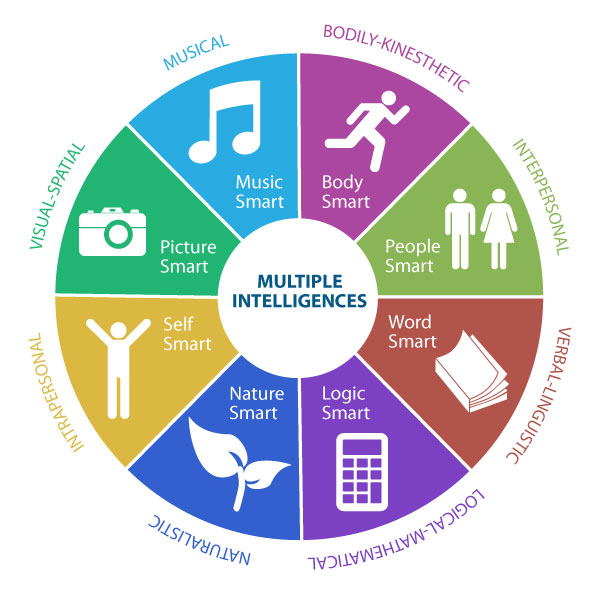
Gardner’s theory of multiple intelligence (गार्डनर के बहु – बुद्धि सिद्धांत) for CTET, all State TETs, KVS, NVS, DSSSB etc
Q. According to Gardner’s theory of multiple intelligences, spatial intelligence-
- Consists of the ability to detect patterns, reasoning deductively and think logically
- Gives one the ability to manipulate and create mental images in order to solve problems
- is the ability to use one’s mental abilities to coordinate one’s own bodily movements.
- Is the ability to understand and discern the feelings and intentions of others.
Ans- Option B
Gardner defines intelligence, as the capacity to solve problems, using biological as well as cultural research.
It formulated a list of 8 intelligences-
- Musical-rhythmic and harmonic Intelligence-
This area has to do with sensitivity to sounds, rhythms, tones, and music.
2. Logical mathematical intelligence-
consists of the ability to detect patterns, reason deductively and think logically
3. Linguistic intelligence-
involves having a mastery of language
4. Spatial intelligence-
Gives one the ability to manipulate and create mental images in order to solve problems
5. Body kinesthetic intelligence is the ability to use one’s mental abilities to coordinate one’s own bodily movement.
6. Personal intelligence-
the ability to understand and discern the feelings and intentions of others.
7. Intrapersonal intelligence is the ability to understand one’s own feelings and motivations
8. Naturalistic intelligence-
Not part of Gardner’s original seven, naturalistic intelligence was proposed by him in 1995. Naturalistic intelligence may be explained as, The individual who is readily able to recognize flora and fauna, to make other consequential distinctions in the natural world, and to use this ability productively (in hunting, in farming, in biological science) is exercising an important intelligence and one that is not adequately encompassed in the current list.
Q. गार्डनर के बहु – बुद्धि सिद्धांत के अनुसार, स्थानिक बुद्धिमत्ता –
- तार्किक योग्यता एवं गणितीय कार्यों से संबंधित है
- समस्याओं को हल करने के लिए मानसिक कल्पनाओं को चित्र का स्वरूप देने से संबंधित है
- आत्मबोध, पहचान तथा स्वयं की भावनाओं एवं कौशल क्षमता को जानने से संबंधित है
- दूसरों की भावनाओं और इरादों को समझने की क्षमता है।
Ans- विकल्प B
बहु-बुद्धि का सिद्धांत हावर्ड गार्डनर (Howard Gardner) द्वारा प्रस्तुत किया गया। उनके अनुसार, बुद्धि कोई एक तत्व नहीं है बल्कि कई भिन्न-भिन्न प्रकार की बुद्धियों का अस्तित्व होता है। प्रत्येक बुद्धि एक दूसरे से स्वतंत्रा रहकर कार्य करती
जैविक और साथ ही सांस्कृतिक अनुसंधान का उपयोग करते हुए 8 प्रकार की बुद्धि की एक सूची तैयार की-
- सांगीतिक बुद्धि-
इस क्षेत्र में ध्वनियों, लय, स्वर और संगीत की संवेदनशीलता में बुद्धि का प्रयोग होता है।
2. तार्किक गणितीय बुद्धिमत्ता-
बुद्धि का यह अंग तार्किक योग्यता एवं गणितीय कार्यों से संबंधित है।
3. भाषाई बुद्धि-
इस बुद्धि में भाषा की निपुणता शामिल है।
4. स्थानिक बुद्धि-
इस तरह की बुद्धि का उपयोग अंतरिक्ष यात्रा के दौरान तथा मानसिक कल्पनाओं को चित्र का स्वरूप देने में किया जाता है।
5. शारीरिक गतिक बुद्धि
किसी की शारीरिक क्षमताओं का समन्वय करने की मानसिक क्षमताओं का उपयोग करने की क्षमता है।
6. अतः पारस्परिक बुद्धि-
दूसरों की भावनाओं और इरादों को समझने की क्षमता।
7. अतः वैयक्तिक बुद्धि
अपनी भावनाओं और प्रेरणाओं को समझने की क्षमता है।
8. प्राकृतिक बुद्धि-
यह गार्डनर के मूल सात बुद्धि का हिस्सा नहीं है, प्राकृतिक बुद्धि का प्रस्ताव उनके द्वारा 1995 में किया गया था। इस प्रकार के ज्ञान का संबंध वनस्पति जगत, पेड़ पौधे, जीव जंतु या प्राणी समूह को परखने आदि में होता है।
(Child Development and Pedagogy: Multiple Intelligence)
